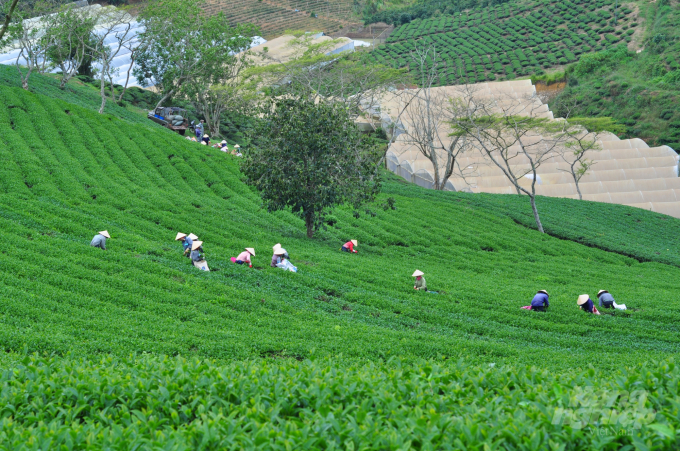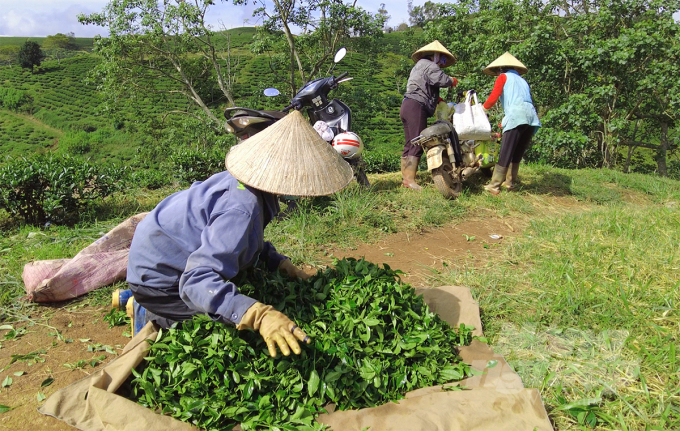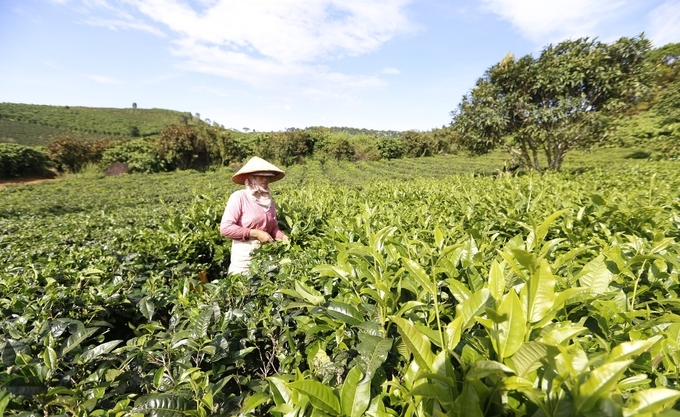December 30, 2025 | 23:15 GMT +7
December 30, 2025 | 23:15 GMT +7
Hotline: 0913.378.918
December 30, 2025 | 23:15 GMT +7
Hotline: 0913.378.918

By the end of 2022, Lam Dong province had over 11 thousand hectares of tea with an output of over 160 thousand tons. Photo: Minh Hau.
Lam Dong is considered favorable for agricultural development, of which over 200,000 hectares of basalt land in Bao Lam, Di Linh, Lam Ha, Bao Loc, and Da Lat districts are suitable for tea development.
By the end of 2022, the province had over 11,000 hectares of tea, the average yield was about 15 tons/ha, and the output was over 160,000 tons. Currently, Bao Lam district is the province with the most extensive tea area in the province, with over 7,000 hectares, followed by Bao Loc City with approximately 2,500 hectares, the rest Lam Ha district, Da Lat City, Di Linh has an area of 160 hectaresto over 500 hectares.
Lam Dong has organized various changes to develop the tea industry in recent years. Accordingly, every year, old tea seeds are converted to an area of high-yield and high-quality tea associated with purchasing and processing enterprises such as TB14, Olong, Qua Quy, Kim Tuyen, and Ngoc Thuy varieties. Along with that is to build and expand the production area of quality tea according to VietGAP standards, tea in the direction of high technology.
Nguyen Van Chau, Deputy Director of Lam Dong Province's Department of Agriculture and Rural Development, said many businesses have linked with farmers in production, creating favorable conditions for farmers to access advanced techniques to improve productivity and product quality.
Lam Dong province has 19 tea production chains with more than 300 households connected with a total area of 1,600 hectares, and the output of fresh bud tea is about 40,000 tons. In the processing field, this province currently has about 155 investment enterprises with a capacity of nearly 30,000 tons per year and 90 tea processing establishments with a scale of over 17,000 tons per year. Enterprises and tea processing facilities are focused on investing in Da Lat city, Bao Loc city, and the districts of Bao Lam, Lam Ha.

The agricultural sector of Lam Dong province encourages businesses to build their raw material areas to improve productivity and quality. Photo: Minh Hau.
In addition to supplying a large amount of tea to the domestic market, Lam Dong exports approximately 15,000 tons of tea of all kinds each year through markets such as Taiwan, Pakistan, Afghanistan, Russia, and the USA... with a total value of US$ 34.5 million. The local tea export turnover is determined to account for roughly 5% of the province's total export turnover and 11% of the export value of agricultural products.
Lam Dong province has implemented a series of solutions to improve the quality and ensure food safety for tea products. Accordingly, this locality encourages enterprises to build their material areas to improve productivity and quality, especially tea products with stable export markets; strengthen technical management, and conduct trials to identify new generation drugs and biological drugs capable of preventing tea pests and diseases by improving the quality of raw materials in tea growing areas.
Nguyen Thuy Quy Tu, Director of Lam Dong Agro-Forestry-Fisheries Quality Management Sub-Department, said that the agricultural sector is implementing programs to guide farmers in applying scientific and technical measures into production, especially in terms of the structure of new varieties, collection, preliminary processing, investment in the production of certified products, and meeting "food safety" standards to serve the domestic market and export.
The province also reviewed all tea production facilities and determined food hygiene and safety conditions. Also, strictly manage the use of pesticides on tea trees, ensuring that they do not exceed the regulations of significant markets in the world.
In parallel with the organization of production and quality assurance of tea, Lam Dong province also aims to attract investment projects to build and upgrade processing, packaging, and canning facilities according to international standards. There is a credit policy to support the production stage to replant the tea garden and support mechanization in the harvesting stage.

The agricultural sector of Lam Dong province is implementing programs to guide farmers to apply scientific and technical measures to production to improve productivity and quality. Photo: T.C.
Mr. Nguyen Van Chau, Deputy Director of the Department of Agriculture and Rural Development, informed that at present, in terms of markets and maintaining traditional markets, the locality is focusing on finding and expanding export markets. Significantly strengthen the innovation of processing lines and technology to ensure quality. Understanding the tastes and preferences of consumers of the markets is also being promoted. Lam Dong tea industry also aims to research and organize the production of high-class competitive teas such as fruit-flavored, canned, medicinal, and herbal teas.
According to the Department of Agriculture and Rural Development of Lam Dong province, the Afghan government announced a complete ban on importing Vietnamese teas that use tea dyeing chemicals in early May. Also, Pakistani tea importers have been warned against using tea dyeing chemicals by the Pakistan Tea Association and Pakistan Customs.
At the beginning of June, the agricultural sector of Lam Dong province sent a document to enterprises producing and trading tea for export to Pakistan and Afghanistan on the prevention of the use of tea dyeing chemicals.
Through inspection and review of the use of tea and dyeing chemicals by five enterprises producing, processing, and exporting to Pakistan and Afghanistan markets, the Department of Industry and Trade of Lam Dong province determined that these enterprises did not use chemicals during processing and ensured food safety criteria.
The Department of Industry and Trade of Lam Dong province proposed the Lam Dong Provincial People's Committee establish an inspection team and coordinate with the Department of Agriculture and Rural Development and relevant units to strengthen the work of information, propaganda, warning, and prevention of the use of chemicals during tea production and processing.
Translated by Ha Phuc
/2025/12/29/2812-1-182339_699.jpg)
(VAN) The price of mangrove forest carbon credits is high because this forest type not only delivers significant environmental value but also plays a crucial role in addressing other issues.
/2025/12/29/5840-0-115141_514.jpg)
(VAN) From 2026, many EU markets will require shrimp to be electrically stunned before ice immersion, forcing exporters to change technologies to retain market share.
/2025/12/28/4951-2-104623_113.jpg)
(VAN) Rubber exports are forecast to remain under downward pressure in the coming period, as global rubber consumption shows signs of slowing, according to ANRPC's projections.
/2025/12/28/5120-1-093308_94.jpg)
(VAN) Many agricultural products are of sufficient quality to join global supply chains, yet fail to pass the first gateway when entering international markets due to packaging and information in English.
/2025/12/27/2453-2-172141_426.jpg)
(VAN) The sharp decline in the number of EU warnings in 2025 is regarded as a positive signal for the future orientation of Viet Nam’s agricultural exports.
/2025/12/27/1547-2-220434_536.jpg)
(VAN) For many businesses, exporting is a costly trial. But for those choosing a long-term path, small orders are a way to keep markets and learn the rules.
/2025/12/27/2522-1-090748_662.jpg)
(VAN) The 'Large-Scale Rice Field' project has been implemented in An Giang across a total area of more than 5,582 ha, comprising 73 large-scale fields and attracting the participation of 2,027 farmer households.